In writing Ulysses, Joyce took great care to represent as accurately as possible the Dublin of June 16th, 1904, consulting maps and street directories, timing routes, and writing letters to friends and family to check minute local details. Why then is the novel so strange? Why does it present its world in so challenging a manner? Seen among the English-language novels of its day, Ulysses looks obscure and anomalous. Yet read in the context of contemporaneous European artistic experimentation, it comes into focus.
This “monster novel,” as Joyce himself called it, responds to the Italian, Swiss, and French avant-garde movements that he encountered while writing Ulysses in three cities whose importance he signals in the final words of Ulysses: “1914-1921 Trieste-Zurich-Paris.” In those cities, Futurist, Dada, and Surrealist artists used iconoclastic practices to rebel against aesthetic, social and political norms.
In contrast to the Futurists' masculinism, Ulysses features a sensitive male central character
These artists manifested a joyful independence lacking in one of Joyce’s main characters, the young would-be artist Stephen Dedalus, who bemoans his servitude to the “imperial British state… and the holy Roman catholic and apostolic church,” and a third, unspecified master, “who wants me for odd jobs,” which we might understand as the cause of Irish identity and independence.
Early 20th-century European avant-garde artists invented new means to resist the pressures of empire and of national identity, to counter the weight of the historical past and the violence of war, and to give voice to the transformative energies of their moment. Their non-conformity, irreverence, and experimentalism helped Joyce to conceive of a novel that was free.
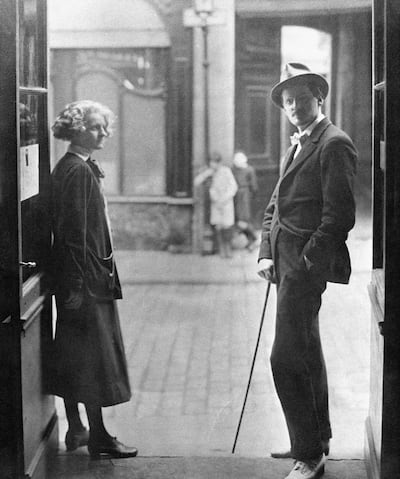
Joyce left Dublin with Nora Barnacle in 1904 and, following a position for Joyce as an English teacher, the couple settled in Trieste. A major harbour of the Austro-Hungarian Empire, Trieste was a cosmopolitan city, whose blending of races and ethnicities, including Italians, Slavs and Germans, with a strong Jewish contingent, formed a lasting influence on Joyce. “Our Beautiful Tinderbox” Filippo Tommaso Marinetti called the city, although its multiculturalism was in stark contrast to the imperialist nationalism he promoted through the Futurist movement he launched in 1909.
Marinetti declared Trieste one of the three capitals of Futurism, along with Milan and Paris. He staged a highly controversial event in a theatre there in 1910, at which he read a manifesto celebrating youth, patriotism, and violent gestures, calling for the incineration of libraries and the demolition of museums. This characteristic Futurist aggression towards the past was met with protests from the audience. Joyce may even have been present at the event but, in any case, he certainly knew about it: several of his friends were in the audience, the newspapers covered it widely, and the city was blanketed in advance with promotional material.
One of Futurism’s most influential gestures was the subversive orthography of its publications: Marinetti’s strategy of parole in libertà, “words in freedom,” abandoned punctuation and released words from linear sequence, mixing font types and sizes. What might seem normal to hipster menus today was at the turn of the 20th century a means of vividly evoking the simultaneous and discordant stimuli of the modern city, the dynamism of modern technologies of transport, communication and warfare. We can link to Futurist orthography the graphic liberties Joyce takes in Ulysses, such as the cheeky headlines of “Aeolus”, the intrusive musical notation of “Sirens, and the excessively large full stop of “Ithaca.”
We know that Joyce engaged with the principles of Futurism in Ulysses. He asked his brother Stanislaus if he found the “Cyclops” episode Futurist, suggesting that its belligerent hyper-nationalist character, “the citizen,” is an embodiment of Marinetti’s political ethos. In contrast to the Futurists’ masculinism, Ulysses features a sensitive male central character. The episode opposes Leopold Bloom’s gentle insistence on tolerance and compassion to the citizen’s aggression towards any non-Irish ethnicity.
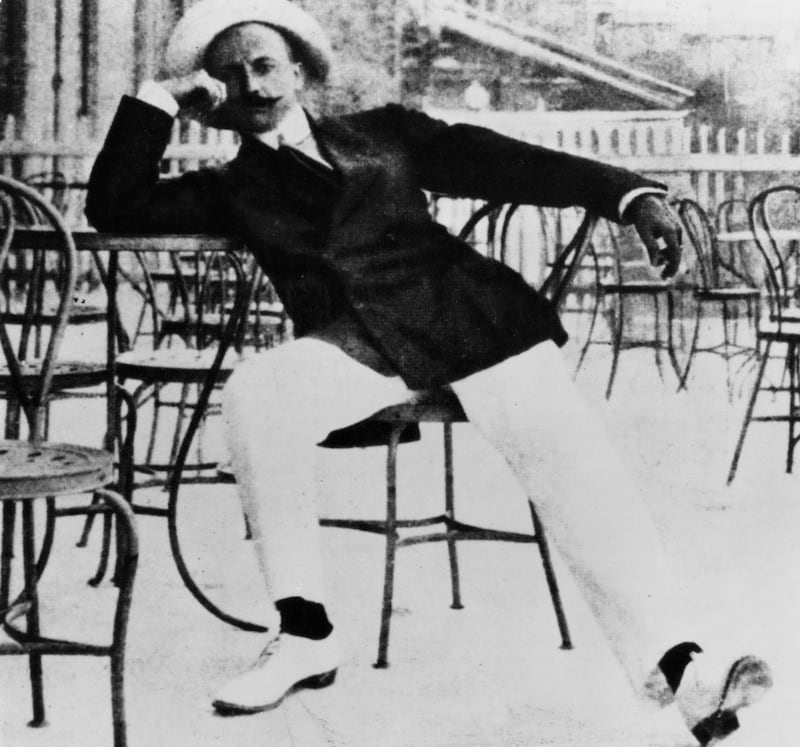
Joyce responds in the episode to the Futurist cultural ethos of tabula rasa by showcasing the culture of the past even while subverting it. The escalating encounter between Bloom and the citizen is interspersed with comic passages that parody Irish antiquarianism and mythology, suggesting that freedom from the past can be achieved without its obliteration.
The Futurist call for destruction was a creative artistic principle, a dynamising gesture that injected vigour and novelty into the international artistic scene. It established an avant-garde discourse that centred on radical disruption of the status quo and on dismantling artistic culture that was separate from everyday life.
This attitude took on increased relevance with the outbreak of the first World War, when an international group of artists sheltering from the war in neutral Zurich held a series of cacophonous soirées. Hugo Ball, the instigator of the soirées, wrote: “The activity and interests of those involved in the cabaret clearly show that it is aimed at the few independent thinkers whose ideals extend beyond the war and their native lands.”

The Dadaists attacked not only national identity but also sense itself. Understanding rational discourse as complicit in the slaughter of the war, they practised a mode of live performance that assaulted their audiences with multiple genres, languages and voices. In contrast to Futurism’s clear principles, Dada refused any guiding idea. Dada, “yes yes” in Romanian and “hobby horse” in French, meant nothing, Ball asserted.
Joyce, a British subject on enemy territory when the war broke out, moved with his family to Zurich in 1914. They lived close to theatre at Speigelgasse 1 where the Cabaret Voltaire began in 1916 but the Dada movement, like Futurism, was impossible to ignore. As Dada artists used found materials in performances and collages, Joyce recast in Ulysses the physical details and ephemera of June 16th, 1904. Whereas Dada’s emphasis on spontaneity and chance differs fundamentally from his painstaking writing and rewriting, the intended effect of Dada’s barrage of words resembles the effect of the Ulyssean multiplicity of references.
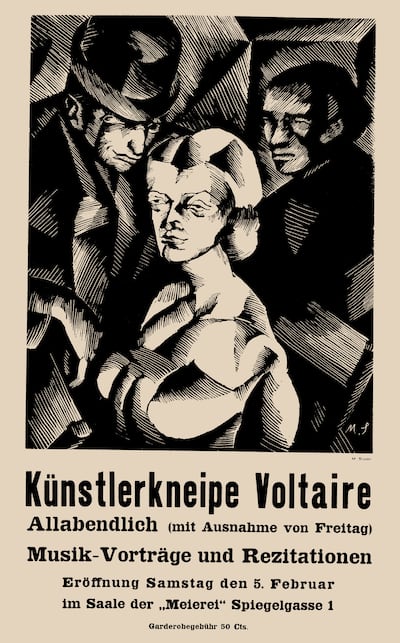
In contrast to the transmission of received sense, Dada aimed to foster independent and creative audience members. Tristan Tzara understood the movement’s poetry as: “letting each listener make links with appropriate associations. He retains the elements characteristic of his personality, mixes them, the fragments etc., remaining at the same time in the direction the author has channelled.”
While every sentence of Ulysses calls for readers to make associations, at the larger scale, the novel’s changing form makes even more insistent demands. We can see this unprecedented narrative shape-shifting as licensed by the wild juxtapositions of the Dada little magazines which combine manifestos, poems, visual and verbal experiments, theoretical statements, collages, reproductions of artworks, slogans, automatic writing and popular art. These rebellious liberties taken during the turmoil of the first World War lent energy to Joyce’s reconception in Ulysses of Homer’s Odyssey, the story of Odysseus’s homeward wanderings after the Trojan War.
Joyce's iconoclastic work recasts literary and artistic culture to open up the possibilities of the everyday world
His “monster novel” combines an astonishing array of narrative techniques: a new “initial style” that combines interior monologue and third-person narrative; interruptive headlines; musical notation; disjointed impersonal narratives; musical prose; parodies of literary English; a hallucinatory playscript; a wandering assemblage of misnomers, malapropisms and cliches; a scientific catechism; and an unpunctuated transcription of night-time thoughts.
After the war ended, Trieste was no longer affordable for the Joyces and Paris’s favourable exchange rate attracted them as it had scores of artists. The city was not new to Joyce; he had moved there in 1902, ostensibly to study medicine but drawn by the works of 19th century avant-garde writers such as Charles Baudelaire, Gérard de Nerval, and Arthur Rimbaud. Returning to Paris almost 20 years later, he moved into a new phase. Throughout the composition of Ulysses, Joyce melded multiple influences with a massive range of literary and historical references but, writing the “Circe” episode in Paris in 1920, he restages all of the preceding characters and events of the book.
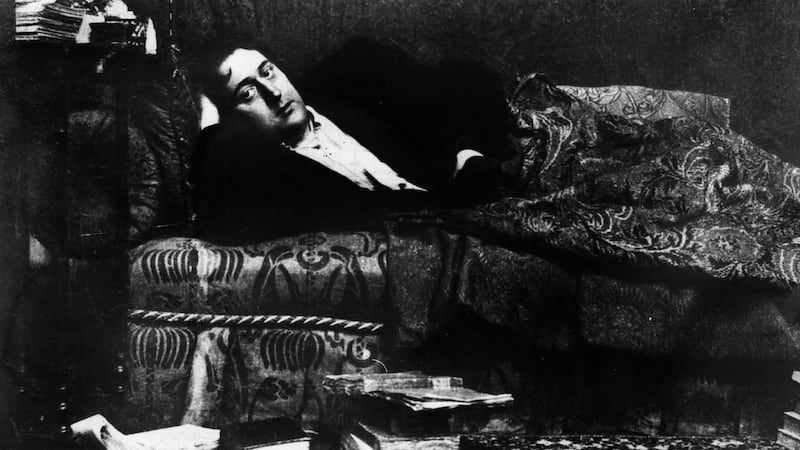
On arriving in the capitol, he wrote with great interest of another Homeric adaptation, Guillaume Apollinaire’s The Breasts of Tiresias, the first Surrealist play. Apollinaire indeed coined the term surrealism, inventing it to characterize a ballet produced by Diaghilev, Picasso, Satie and Cocteau: “a sort of sur-realism in which I see the point of departure for a series of manifestations of that New Spirit which… promises to modify the arts and the conduct of life from top to bottom in universal joyousness.” Joyce follows Apollinaire’s feverish production with a playscript that interrupts Bloom’s visit to the red-light area of Dublin with a series of waking dreams.
There are striking simularities between the two pieces; “O, I do so want to be a mother” Bloom declares, before giving birth to octuplets, recalling the unnamed husband’s announcement in The Breasts of Tiresias: “Ah! The mad joys of paternity! 40049 children in a single day! My happiness is complete.” Male reproduction on an industrial scale has nationalist and colonial consequence in Apollinaire’s play; in Ulysses, it speaks to the promises and limits of capitalism.
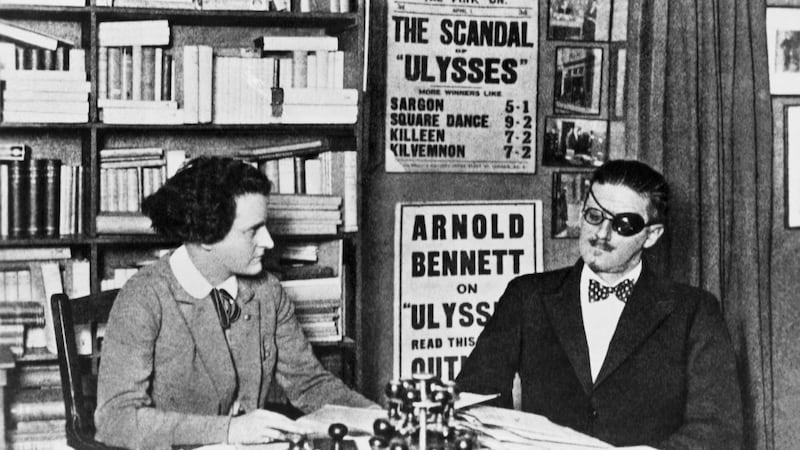
Surrealists like Apollinaire were indebted to the 19th-century French writers who had inspired Joyce as they coined a new artistic language to give voice to the desires awoken and repressed in the modern capitalist city. The avant-garde movements of the 20th century were also related to one another: Apollinaire’s “calligrammes,” or word-image poetry, along with Marinetti’s parole in libertà poems, were celebrated by the Dadaists.
These artists considered themselves the vanguard of a new society. Ulysses, considered in these contexts, can be understood to reconceive of the nature and role of avant-garde art. Neither the artistic equivalent of an advance battalion nor the dismantling of the institution of art tout court, Joyce’s iconoclastic work recasts literary and artistic culture to open up the possibilities of the everyday world.
The Cambridge Centenary Ulysses, edited by Catherine Flynn, will be published in June by Cambridge University Press














